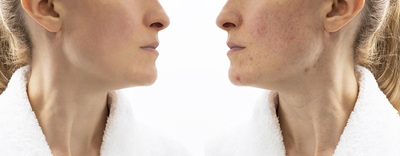Best In-Office Treatments for Rosacea

Even though there’s no cure for rosacea, there are plenty of in-office treatments for rosacea. While no treatment can cure your rosacea completely, it can greatly reduce your symptoms and minimize flare-ups.
From prescription topicals to laser therapy, here are some of the best treatments for rosacea you’ll find in our dermatology offices.
Prescription Topicals for Rosacea
Prescription topicals are a popular choice for treating rosacea symptoms. Here are some of the most successful topicals.
Rhofade
The U.S. Food & Drug Administration approved RHOFADE™ (oxymetazoline HCl cream 1%) after a study showed that the cream provides significant improvement for facial redness associated with rosacea.
It’s also very low-risk, with side effects like irritation and itching occurring only rarely. However, Rhofade isn’t a cure-all treatment and you’ll still have to use other treatments to control rosacea flare-ups.
If your dermatologist prescribes Rhofade for you, apply it once a day to your forehead, nose, cheeks, and chin.
Azelaic Acid
Unlike Rhofade, which primarily treats redness, azelaic acid treats the lesions, or pimples and bumps, associated with some forms of rosacea. When applied twice daily, it can reduce the size and number of lesions.
Common brand names include Finacea and Azelex, though you can also find azelaic acid in smaller concentrations in some skin care products since it’s helpful for reducing flaky skin and acne.
Sodium Sulfacetamide
Sodium sulfacetamide is an antibiotic that comes in several different forms, including soap and lotion. It controls acne by blocking the growth of bacteria on your skin and also helps manage the lesions caused by rosacea.
Your dermatologist will probably advise you to apply it twice daily to the affected area.
Metronidazole
Metronidazole is another antibiotic that can be taken topically (or orally) to treat redness and pimples. MetroCream and MetroGel are common brand types.
Metronidazole is usually applied twice daily.
Elidel
Elidel (pimecrolimus) is a topical cream used to treat eczema that can also reduce the inflammation associated with rosacea.
Aczone
Aczone is another topical that isn’t specifically designed for rosacea but can help. Aczone was designed and studied for treating acne, so it works well in people who have a combination of acne and rosacea.
Oral Antibiotics for Rosacea
Antibiotics can reduce rosacea symptoms because of their anti-inflammatory properties. Tetracycline, doxycycline, minocycline, and metronidazole are all oral antibiotics commonly used to treat rosacea.
Most dermatologists prescribe antibiotics only for severe cases of rosacea and try to wean patients off once their symptoms have died down.
Laser Treatments for Rosacea
Laser treatment disintegrates blood vessels close to the skin’s surface by targeting them with light and heat. This means visible symptoms of rosacea, such as visible blood vessels, overall redness, and thickened skin can be reduced with laser treatment.
Most patients who receive laser treatment for visible blood vessels see a 50% to 75% rate of improvement. Certain types of lasers can also be used to correct the nose enlargement that sometimes occurs with rosacea.
But it’s important to remember that, like most treatments for rosacea, laser therapy isn’t a cure. It’s simply a way of managing symptoms.
Your dermatologist will probably suggest three or four treatments, depending on the severity of your rosacea and the symptoms that are being treated. Results can last for three to five years, after which time you may need to go in for another session.
Since laser therapy doesn’t treat the bumps that occur with rosacea, you’ll probably need to continue using topical or oral medication along with your laser treatment.
Light Therapy for Rosacea
Light therapy can also be effective in reducing redness, bumps, and swelling brought on by rosacea.
Most people start with red light therapy, though several different wavelengths exist – amber, green, and blue – for treating different types of rosacea.
Like laser treatment, light therapy works best when used in combination with topicals or antibiotics.
Are you struggling with rosacea?
The best treatment for rosacea is simply the one that works for you. No two cases are the same, so you and your dermatologist may need to do a little experimenting before you hit on the right combination that works for you.
If you’re suffering from rosacea, make an appointment with one of our dermatology providers to devise a treatment plan using our advanced technology and cutting-edge lasers and lights.
Call Schweiger Dermatology Group at (844) DERM-DOC to schedule a consultation today. To find a location near you, check out our location pages.
